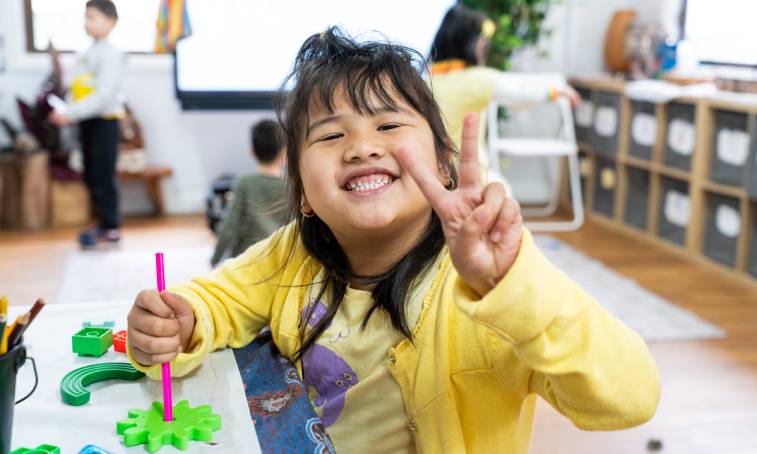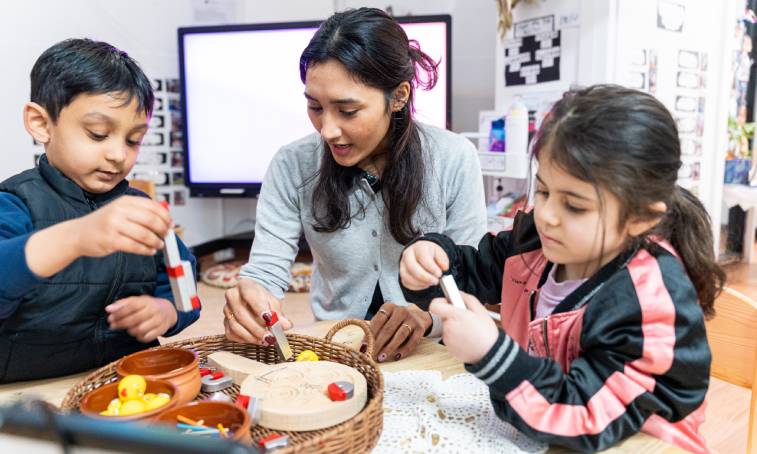Screens have their place, but nothing sparks imagination quite like a book. Stories invite children to wonder, question, and create. Turning everyday moments into adventures.
Books don’t just teach language. They build creativity by opening doors to new worlds, new characters, and new possibilities. Whether it’s rhymes that roll off the tongue or pictures that beg to be imitated, reading plants the seeds of imaginative thinking.
At Next Generation Kindergarten, we see this every day. Books are woven into our play-based learning because they do more than entertain; they inspire children to create stories of their own.
Here are 30 of our favourite books that fuel creativity in children of all ages.
1. Classic Stories That Never Fad
Some books are timeless for a reason. Their playful language and inventive worlds continue to spark imagination across generations.
The Cat in the Hat – Dr. Seuss
Chaos meets rhyme in this mischievous classic. The playful rhythm makes reading aloud an event, while the upside-down antics show children that rules can be bent in the name of creativity.
Green Eggs and Ham – Dr. Seuss
Simple words, silly scenarios, and repetition keep children engaged. Its nonsense combinations inspire children to experiment with their own rhymes and playful ideas.
Winnie the Pooh – A.A. Milne
Gentle adventures in the Hundred Acre Wood show how curiosity and friendship create endless possibilities. Children learn that imagination thrives in simple moments.
A Bear Called Paddington – Michael Bond
This story of a polite bear in a new world encourages children to see challenges as opportunities for creative problem-solving. Paddington shows that kindness and humour can turn confusion into discovery.
The Wind in the Willows – Kenneth Grahame
With vivid scenes of rivers, meadows, and whimsical characters, this tale draws children into detailed imaginative play. It inspires them to build adventures outdoors with nature as their stage.
2. Australian Stories with Local Flair
Local stories connect imagination to familiar places, animals, and traditions, helping children see creativity in their own backyard.
Possum Magic – Mem Fox
A magical journey through Australia, blending food, family, and discovery. Children connect culture with imagination, sparking conversations about traditions and identity.
Wombat Stew – Marcia Vaughan
A cheeky story of animals and their stew that turns into a clever twist. The rhymes encourage children to invent silly recipes and stories of their own.
Diary of a Wombat – Jackie French
Simple observations turn into a playful narrative, showing children that even small daily routines can be transformed into stories worth telling.
Who Sank the Boat? – Pamela Allen
This suspenseful picture book builds problem-solving and prediction skills. Children love guessing outcomes and retelling the story with their own “what if” endings.
Koala Lou – Mem Fox
A poetic tale of love and determination. Its emotional storytelling helps children imagine their own stories of perseverance and connection.
3. Interactive Picture Books
Books that invite children to lift flaps, touch textures, or search for clues turn reading into a game, keeping creativity alive through play.
Dear Zoo – Rod Campbell
Children lift flaps to reveal surprise animals. It builds anticipation and encourages playful thinking about what could be hiding next.
Where’s Spot? – Eric Hill
This hide-and-seek adventure sparks problem-solving as children guess where Spot might be. It invites them to create their own hiding games afterwards.
Each Peach Pear Plum – Janet and Allan Ahlberg
A rhyming “I spy” story where fairy tale characters pop up on every page. Children enjoy spotting details and retelling the story in their own words.
Hairy Maclary and Friends: Touch and Feel – Lynley Dodd
Adding textures to a beloved story gives children a sensory experience. It encourages them to connect words, touch, and imagination in one playful moment.
The Very Cranky Bear – Nick Bland
Bold illustrations and humour keep children engaged, while the playful animals encourage empathy and creative problem-solving in tricky situations.
4. Books That Blend Art and Words

Some stories shine not just in language, but in artwork, sparking creativity on both the page and beyond it.
The Rainbow Fish – Marcus Pfister
Its shimmering pages invite artistic expression while teaching the beauty of sharing. Children are inspired to draw, paint, or make their own glittery creations.
The Magic Faraway Tree – Enid Blyton
A fantastical tree full of magical lands fuels “what if” thinking. Children imagine new lands of their own, turning storytelling into endless invention.
The Day the Crayons Quit – Drew Daywalt
Colours have personalities and complaints in this playful tale. It sparks emotional awareness and encourages children to imagine everyday objects with voices.
Giraffes Can’t Dance – Giles Andreae
A tale of self-acceptance that inspires children to explore movement, rhythm, and creativity in dance. Its bold art makes every page an invitation to move.
The Tiger Who Came to Tea – Judith Kerr
Mixes ordinary routines with a fantastical twist. Children learn that even the simplest settings can spark wild, creative adventures.
5. Creative Reads for Toddlers
Toddlers thrive on repetition, rhyme, and illustrations that feel interactive. These titles encourage creativity while keeping routines gentle.
Goodnight Moon – Margaret Wise Brown
Simple rhythm and soothing repetition turn bedtime into a creative ritual. Its patterns inspire toddlers to notice details in their own world.
Guess How Much I Love You – Sam McBratney
This gentle tale uses exaggeration and imagination to express love. Children mirror this creativity by inventing their own comparisons.
Blueberries for Sal – Robert McCloskey
A simple story of picking berries sparks cause-and-effect thinking and invites children to connect storytelling to everyday routines.
Ten Little Fingers and Ten Little Toes – Mem Fox
Celebrates diversity and connection through rhyme and illustration. It encourages children to see creativity in self-expression and belonging.
Where is the Green Sheep? – Mem Fox
Encourages playful guessing and prediction. Children delight in imagining their own “missing” characters and endings.
6. Big Ideas for School-Aged Readers
As children grow, longer stories let them explore more complex creativity, from problem-solving to world-building.
Matilda – Roald Dahl
A celebration of knowledge and courage. Children are inspired to imagine their own “magic powers” of cleverness and creativity.
Room on the Broom – Julia Donaldson
Friendship and teamwork come alive in this rhyming tale. Children are encouraged to invent their own magical companions and adventures.
The Gruffalo – Julia Donaldson
A witty rhyming story where imagination triumphs over fear. Children love retelling it, which builds confidence in storytelling and creative problem-solving.
The BFG – Roald Dahl
Inventive language and dream-catching adventures open doors to imaginative wordplay and fantastical thinking.
The Lion, the Witch and the Wardrobe – C.S. Lewis
A classic fantasy that mixes moral bravery with magical worlds. It inspires imaginative play, costume games, and adventurous storytelling.
7. Stories That Spark Emotional Creativity [Bonus]
Beyond home and family, children thrive when surrounded by environments that actively encourage leadership through play, learning, and real-life practice.
Here We Are – Oliver Jeffers
A beautifully illustrated introduction to the world. It sparks wonder and encourages children to see creativity in nature and human connection.
Pig the Pug – Aaron Blabey
Exaggerated humour makes lessons about sharing and kindness memorable. Children often retell the story in silly ways, building creative communication.
Mr Gumpy’s Outing – John Burningham
A cheerful chaos of animals joining a boat ride. Its simplicity inspires children to imagine their own playful adventures.
Franklin’s Flying Bookshop – Jen Campbell
Celebrates friendship and the love of books. It encourages children to dream big and create their own stories of cooperation.
Alice-Miranda – Jacqueline Harvey
This series blends humour, mystery, and resilience. It shows children how creativity can help solve challenges and strengthen friendships.
How to Use These Books at Home
You don’t need all 30 to inspire creativity. Start with a few that fit your child’s age and interests.
🗹 For toddlers: choose rhythmic picture books with rhyme and repetition.
🗹 For preschoolers: interactive stories that invite guessing, rhyming, or acting.
🗹 For school-aged: longer tales that spark retelling, role play, or creative projects.
Reading doesn’t need to be a strict bedtime routine. It can be during breakfast, bath time, or a quiet moment in the park. Creativity grows in shared moments, not just scheduled ones.
Let Their Imagination Grow
Books aren’t just stories; they’re sparks. They ignite ideas, emotions, and playful thinking that children carry far beyond the page.
At Next Generation Kindergarten, books are part of our daily rhythm. They’re read, acted out, drawn, and retold. Turning creativity into a living, joyful practice.
Come visit our Chester Hill centre and see how stories inspire children to imagine, create, and grow every day.
FAQs
How often should I read with my child to spark creativity?
Even 10–15 minutes a day makes a difference. Consistency matters more than long sessions; short daily reading keeps imagination alive.
What if my child prefers screens to books?
Start with interactive or funny stories that feel fast-paced, then connect books to their interests. Mixing stories with drawing or acting makes reading feel less like a “task.”
Do I need to buy all 30 books?
Not at all. Pick a handful that suits your child’s age and personality. Libraries and local book swaps are also great for trying different titles.
How can I make storytime more creative?
Pause to ask questions like, “What do you think happens next?” or “Can you draw your version of this character?” Involving your child makes the story interactive.
Are these books suitable for group reading?
Yes. Many like The Gruffalo or Where’s Spot? are perfect for classrooms, siblings, or playgroups. Group reading sparks collaboration and shared creativity.

